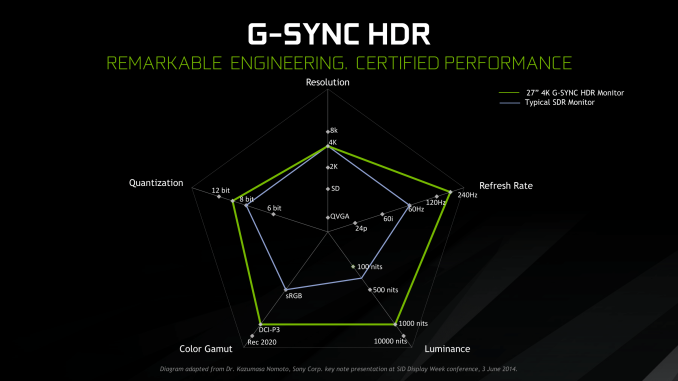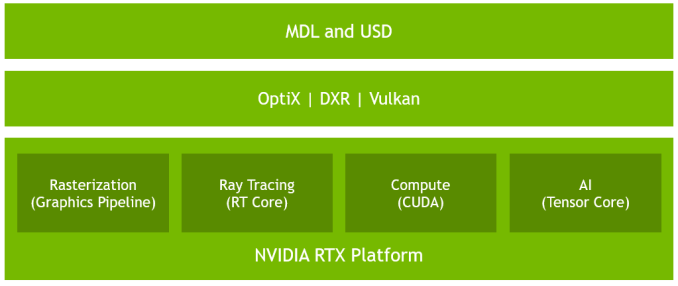The NVIDIA GeForce RTX 2080 Ti & RTX 2080 Founders Edition Review: Foundations For A Ray Traced Future
by Nate Oh on September 19, 2018 5:15 PM EST- Posted in
- GPUs
- Raytrace
- GeForce
- NVIDIA
- DirectX Raytracing
- Turing
- GeForce RTX
Meet The New Future of Gaming: Different Than The Old One
Up until last month, NVIDIA had been pushing a different, more conventional future for gaming and video cards, perhaps best exemplified by their recent launch of 27-in 4K G-Sync HDR monitors, courtesy of Asus and Acer. The specifications and display represented – and still represents – the aspired capabilities of PC gaming graphics: 4K resolution, 144 Hz refresh rate with G-Sync variable refresh, and high-quality HDR. The future was maxing out graphics settings on a game with high visual fidelity, enabling HDR, and rendering at 4K with triple-digit average framerate on a large screen. That target was not achievable by current performance, at least, certainly not by single-GPU cards. In the past, multi-GPU configurations were a stronger option provided that stuttering was not an issue, but recent years have seen both AMD and NVIDIA take a step back from CrossFireX and SLI, respectively.
Particularly with HDR, NVIDIA expressed a qualitative rather than quantitative enhancement in the gaming experience. Faster framerates and higher resolutions were more known quantities, easily demoed and with more intuitive benefits – though in the past there was the perception of 30fps as cinematic, and currently 1080p still remains stubbornly popular – where higher resolution means more possibility for details, higher even framerates meant smoother gameplay and video. Variable refresh rate technology soon followed, resolving the screen-tearing/V-Sync input lag dilemma, though again it took time to catch on to where it is now – nigh mandatory for a higher-end gaming monitor.
For gaming displays, HDR was substantively different than adding graphical details or allowing smoother gameplay and playback, because it meant a new dimension of ‘more possible colors’ and ‘brighter whites and darker blacks’ to gaming. Because HDR capability required support from the entire graphical chain, as well as high-quality HDR monitor and content to fully take advantage, it was harder to showcase. Added to the other aspects of high-end gaming graphics and pending the further development of VR, this was the future on the horizon for GPUs.
But today NVIDIA is switching gears, going to the fundamental way computer graphics are modelled in games today. Of the more realistic rendering processes, light can be emulated as rays that emit from their respective sources, but computing even a subset of the number of rays and their interactions (reflection, refraction, etc.) in a bounded space is so intensive that real time rendering was impossible. But to get the performance needed to render in real time, rasterization essentially boils down 3D objects as 2D representations to simplify the computations, significantly faking the behavior of light.
It’s on real time ray tracing that NVIDIA is staking its claim with GeForce RTX and Turing’s RT Cores. Covered more in-depth in our architecture article, NVIDIA’s real time ray tracing implementation takes all the shortcuts it can get, incorporating select real time ray tracing effects with significant denoising but keeping rasterization for everything else. Unfortunately, this hybrid rendering isn’t orthogonal to the previous concepts. Now, the ultimate experience would be hybrid rendered 4K with HDR support at high, steady, and variable framerates, though GPUs didn’t have enough performance to get to that point under traditional rasterization.
There’s a still a performance cost incurred with real time ray tracing effects, except right now only NVIDIA and developers have a clear idea of what it is. What we can say is that utilizing real time ray tracing effects in games may require sacrificing some or all three of high resolution, ultra high framerates, and HDR. HDR is limited by game support more than anything else. But the first two have arguably minimum performance standards when it comes to modern high-end gaming on PC – anything under 1080p is completely unpalatable, and anything under 30fps or more realistically 45 to 60fps hurts the playability. Variable refresh rate can mitigate the latter and framedrops are temporary, but low resolution is forever.
Ultimately, the real time ray tracing support needs to be implemented by developers via a supporting API like DXR – and many have been working hard on doing so – but currently there is no public timeline of application support for real time ray tracing, Tensor Core accelerated AI features, and Turing advanced shading. The list of games with support for Turing features - collectively called the RTX platform - will be available and updated on NVIDIA's site.













337 Comments
View All Comments
Spunjji - Friday, September 21, 2018 - link
If that were true then Nvidia could have left off the RTX parts this time around and created a GPU that offers a simple ~30% performance improvement at roughly the same retail cost.Following that, the die-area benefits from 7nm could have been spent on both RTX features and another ~30% performance boost at a similar or slightly-higher cost. By then they could probably have added enough resources to at least manage high refresh rates at 1080p, if not 2.5K
Instead they massively inflated their die for features that require you to accept resolutions and frame-rates that PC gaming left behind 6 years ago.
mapesdhs - Wednesday, September 26, 2018 - link
That last sentence is something I which tech sites would emphasise a lot more. It very much defines how those who normally buy into the higher tier tech now regard what they like doing and why. NVIDIA pushed hard to create the market for high-refresh gaming, 4K & VR, now suddenly they're trying to do an about-face. I can't see how it can work. I just bought a 27" 1440p IPS panel for 200 UKP, the cost of good screens has come down a lot, and now NVIDIA wants us to drop back down to 1080p? :D I get the impression the reaction of a great many is just laughter.Gastec - Thursday, September 27, 2018 - link
Ahaa! You are getting close :) Come on, just spell it: they want to "milk" us as much as possible before Moore's Law ends and we will completely stop upgrading our PC's and we'll just replace the defective part twice in a life time. No more billions of moneyz for Corporate Commander :)Yojimbo - Wednesday, September 19, 2018 - link
"Please, let's boycott Turing cards."Throw down your chains and resist!
Ranger1065 - Thursday, September 20, 2018 - link
100%Xex360 - Wednesday, September 19, 2018 - link
These cards are a disappointment for the price, the 2080ti should be priced at most 800$, it just doesn't offer the performance required for justifying its price, worse here they compared it to the 1080ti FE which as GamerNexus pointed out is not ideal, for the cards are noticeably slower than other cards with proper cooling, so the 1080ti is at least as fast as the 2080.On the ray tracing side, I like the technology but it's not impressive enough to justify the hefty price tag, I'd rather have a real generational leap with a 2070 beating a 1080ti and a 2080ti having at least 70% more performance than having RT, it's a niche product and obly few games will benefit from it, and the whole DLSS isn't good either limited to only a few games, with more brut force we could achieve 4k and super sampling.
kron123456789 - Wednesday, September 19, 2018 - link
"I'd rather have a real generational leap with a 2070 beating a 1080ti and a 2080ti having at least 70% more performance than having RT"That reminded me of a very old quote:
"If I had asked people what they wanted, they would have said ‘faster horses.’" — Henry Ford
saikrishnav - Wednesday, September 19, 2018 - link
That quote only makes sense if Nvidia came up with a "different" radical product than a graphical horse. They just made a slightly faster horse with a RTX ON button which nobody is ready to push yet i.e. developers. So, if you have a choice between a much faster horse and a RTX ON button - one would take a much faster horse. Now, when developers are ready to push the button/envelope, and sign on to the RTX, then this quote makes sense. Nvidia is asking customers to pay the price of new tech-adoption without show-casing the products that use it. They could have invested with devs and in games, to use the RTX, and then released it. But no, they want to fill in a gap until 7nm arrives.Yojimbo - Wednesday, September 19, 2018 - link
Nobody was ready to push the mass produced automobile button, yet, either. Do you think Ford started mass producing cars and then immediately there were roads and gas stations? No, at first horses could comfortably go many more places than cars could.His quote is entirely appropriate.
There is no gap to fill before 7 nm arrives since AMD will have no competition. NVIDIA introduced this now because they see value in the product which will generate sales. Plus it will get the ball rolling on developers implementing the new technologies that are present in the architecture and will be present in future NVIDIA architectures.
BurntMyBacon - Thursday, September 20, 2018 - link
Have to agree here. No only where automobiles extremely limited in where they could go on introduction, they were also very loud and considered disruptive to society with a large voice of opposition. These new cards at least have the benefit of being able to go anywhere their predecessors can while still enabling new capabilities.I very much agree that nVidia is using this architecture to "get the ball rolling" on the new tech. They are probably very much aware that sales of RTX cards will be lower until they can fit a meaningful amount of the new hardware resources into a mainstream chip. Though, given the size of the chips and typical associated yields, nVidia may still end up selling every chip they can make.